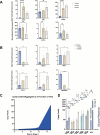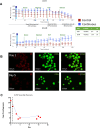Identifying and optimizing critical process parameters for large-scale manufacturing of iPSC derived insulin-producing β-cells
- PMID: 39522051
- PMCID: PMC11550522
- DOI: 10.1186/s13287-024-03973-0
Identifying and optimizing critical process parameters for large-scale manufacturing of iPSC derived insulin-producing β-cells
Abstract
Background: Type 1 diabetes, an autoimmune disorder leading to the destruction of pancreatic β-cells, requires lifelong insulin therapy. Islet transplantation offers a promising solution but faces challenges such as limited availability and the need for immunosuppression. Induced pluripotent stem cells (iPSCs) provide a potential alternative source of functional β-cells and have the capability for large-scale production. However, current differentiation protocols, predominantly conducted in hybrid or 2D settings, lack scalability and optimal conditions for suspension culture.
Methods: We examined a range of bioreactor scaleup process parameters and quality target product profiles that might affect the differentiation process. This investigation was conducted using an optimized High Dimensional Design of Experiments (HD-DoE) protocol designed for scalability and implemented in 0.5L (PBS-0.5 Mini) vertical wheel bioreactors.
Results: A three stage suspension manufacturing process is developed, transitioning from adherent to suspension culture, with TB2 media supporting iPSC growth during scaling. Stage-wise optimization approaches and extended differentiation times are used to enhance marker expression and maturation of iPSC-derived islet-like clusters. Continuous bioreactor runs were used to study nutrient and growth limitations and impact on differentiation. The continuous bioreactors were compared to a Control media change bioreactor showing metabolic shifts and a more β-cell-like differentiation profile. Cryopreserved aggregates harvested from the runs were recovered and showed maintenance of viability and insulin secretion capacity post-recovery, indicating their potential for storage and future transplantation therapies.
Conclusion: This study demonstrated that stage time increase and limited media replenishing with lactate accumulation can increase the differentiation capacity of insulin producing cells cultured in a large-scale suspension environment.
Keywords: Bioprocess development; Bioreactor; Diabetes; DoE; Human induced pluripotent stem cell; Insulin producing cells; Islets; Optimization; Pancreatic cells; iPSCs; β-cells.
© 2024. The Author(s).
Conflict of interest statement
J.J. is founder of and shareholder of Trailhead Biosystems, Inc., Beachwood, OH, USA. M. B. is a shareholder in Trailhead Biosystems, Inc., Beachwood OH. This work has been filed as US Provisional Application No. application pending.
Figures






Similar articles
-
Scalable Bioreactor-based Suspension Approach to Generate Stem Cell-derived Islets From Healthy Donor-derived iPSCs.Transplantation. 2025 Jan 1;109(1):e22-e35. doi: 10.1097/TP.0000000000005108. Epub 2024 Jul 18. Transplantation. 2025. PMID: 39656525
-
Production of pancreatic progenitor cells from human induced pluripotent stem cells using a three-dimensional suspension bioreactor system.J Tissue Eng Regen Med. 2017 Nov;11(11):3193-3201. doi: 10.1002/term.2228. Epub 2017 Mar 20. J Tissue Eng Regen Med. 2017. PMID: 28317340
-
Overcoming bioprocess bottlenecks in the large-scale expansion of high-quality hiPSC aggregates in vertical-wheel stirred suspension bioreactors.Stem Cell Res Ther. 2021 Jan 13;12(1):55. doi: 10.1186/s13287-020-02109-4. Stem Cell Res Ther. 2021. PMID: 33436078 Free PMC article.
-
Differentiation of human pluripotent stem cells into β-cells: Potential and challenges.Best Pract Res Clin Endocrinol Metab. 2015 Dec;29(6):833-47. doi: 10.1016/j.beem.2015.10.011. Epub 2015 Oct 30. Best Pract Res Clin Endocrinol Metab. 2015. PMID: 26696513 Review.
-
Continuous human iPSC-macrophage mass production by suspension culture in stirred tank bioreactors.Nat Protoc. 2022 Feb;17(2):513-539. doi: 10.1038/s41596-021-00654-7. Epub 2022 Jan 17. Nat Protoc. 2022. PMID: 35039668 Free PMC article. Review.
Cited by
-
The Last Mile in Beta-Cell Replacement Therapy for Type 1 Diabetes: Time to Grow Up.Transpl Int. 2025 Apr 1;38:14565. doi: 10.3389/ti.2025.14565. eCollection 2025. Transpl Int. 2025. PMID: 40236754 Free PMC article. Review.
References
-
- T1D Index Website. 2024.
-
- Shapiro AMJ, Lakey JRT, Ryan EA, Korbutt GS, Toth E, Warnock GL, et al. Islet transplantation in seven patients with type 1 diabetes mellitus using a glucocorticoid-free immunosuppressive regimen. N Engl J Med. 2000;343:230–8. - PubMed
MeSH terms
Substances
LinkOut - more resources
Full Text Sources

